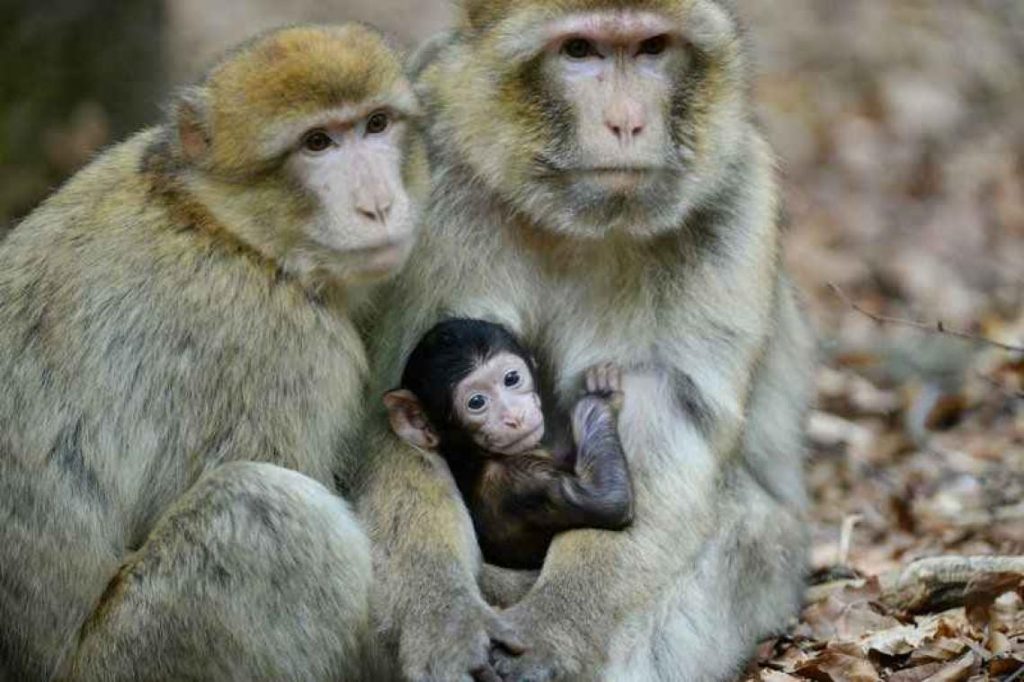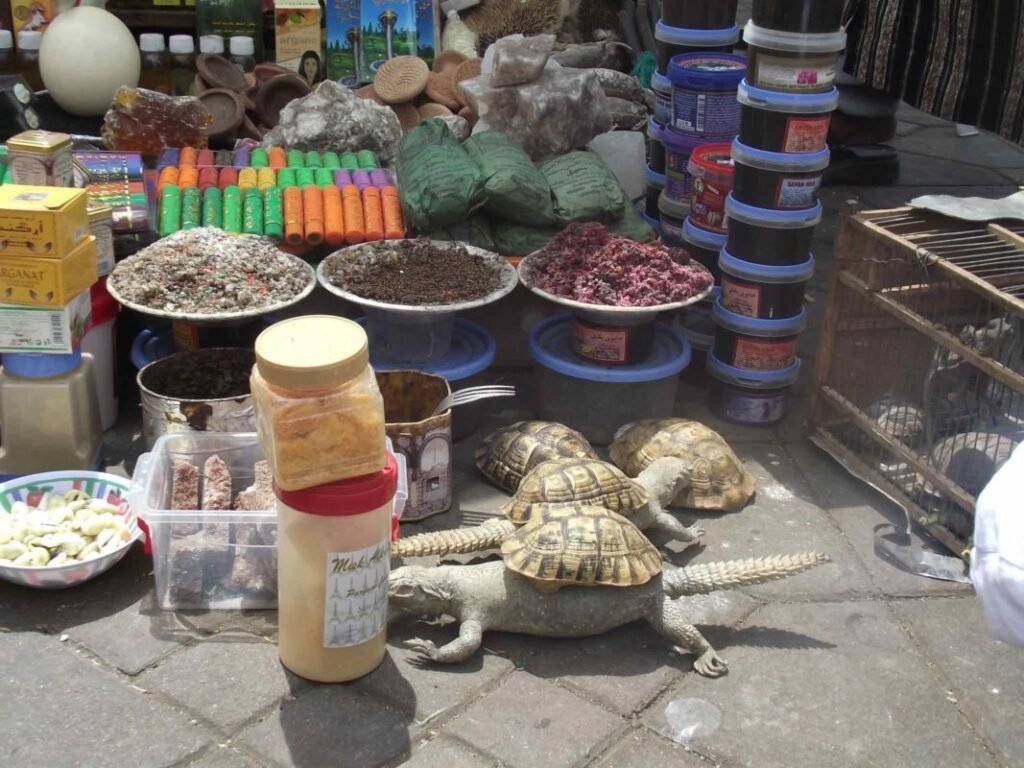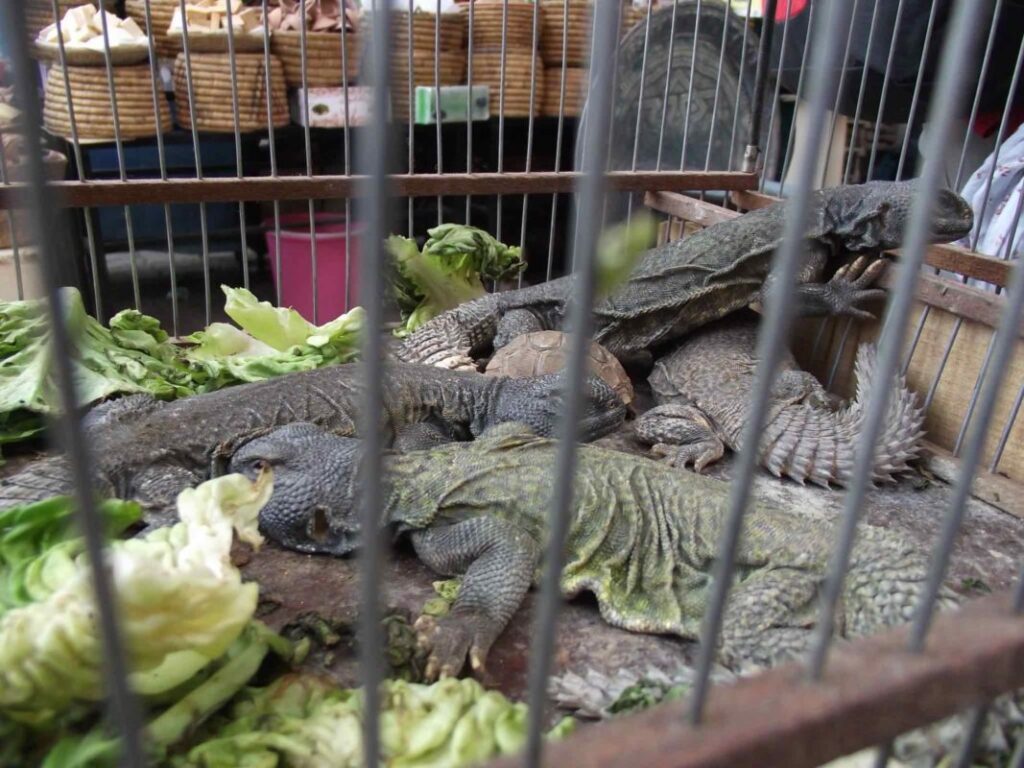Die Humane Society of Morocco ist sich der dringenden Notwendigkeit bewusst, dass akkreditierte Organisationen lokale und internationale Naturschutzbemühungen unternehmen müssen, um die Zerstörung von Lebensräumen und das Artensterben einzudämmen.
Zu den gefährdeten Wildtierarten in Marokko gehören der Berberleopard, der Waldrapp, die Mittelmeer-Mönchsrobbe, die Berberhyäne, die Cuviers-Gazelle und der Spanische Kaiseradler.

Wildtierprobleme und der Handel mit Wildtieren stellen in Marokko erhebliche Herausforderungen für den Schutz der biologischen Vielfalt und den Tierschutz dar. Trotz der Bemühungen, einheimische Wildtierarten zu schützen, bleibt der illegale Wildtierhandel aufgrund der Nachfrage nach exotischen Haustieren, traditioneller Medizin und Luxusgütern ein dringendes Problem.
Eines der größten Wildtierprobleme in Marokko ist die Wilderei gefährdeter Arten. Wildereraktivitäten, die durch die internationale Nachfrage nach Wildtierprodukten angeheizt werden, bedrohen das Überleben dieser ikonischen Arten und stören empfindliche Ökosysteme.
Darüber hinaus ist in Marokko der Handel mit Vögeln, Reptilien und anderen exotischen Tieren für den Heimtierhandel weit verbreitet. Viele dieser Tiere werden in der Wildnis gefangen und über die Grenzen geschmuggelt, was zu Populationsrückgängen und ökologischen Ungleichgewichten führt. Darüber hinaus geht der illegale Handel mit Wildtieren oft mit Grausamkeit und Ausbeutung einher, wobei die Tiere beim Fang, Transport und Verkauf Stress, Verletzungen und unmenschlicher Behandlung ausgesetzt sind.
Um den Wildtierhandel in Marokko zu bekämpfen, sind konzertierte Anstrengungen erforderlich, um die Strafverfolgung zu stärken, das öffentliche Bewusstsein zu schärfen und nachhaltige Alternativen zur Verwendung von Wildtierprodukten zu fördern. Die Zusammenarbeit zwischen Regierungsbehörden, Nichtregierungsorganisationen und lokalen Gemeinschaften ist von entscheidender Bedeutung, um die Ursachen des illegalen Wildtierhandels anzugehen und die Artenvielfalt für künftige Generationen zu schützen.
Die Humane Society of Morocco ist bestrebt, das Bewusstsein für Wildtierprobleme und den Handel mit Wildtieren in Marokko zu schärfen, indem sie Informationen über Naturschutzinitiativen, Meldemechanismen für Wildtierkriminalität und Möglichkeiten für Einzelpersonen bereitstellt, sich an Wildtierschutzbemühungen zu beteiligen.
Gemeinsam können wir auf eine Zukunft hinarbeiten, in der Wildtiere in ihren natürlichen Lebensräumen gedeihen, frei von der Bedrohung durch Ausbeutung und Handel.

In vielen der Tausenden von Geschäften, die die Straßen der Medinas Marokkos säumen, finden Käufer sogenannte „Kräuterhändler“, die sich auf Kräuter, Gewürze, Öle und traditionelle Arzneimittel spezialisiert haben.
In diesen Geschäften findet man häufig Reptilien und deren Teile, eine Praxis, die noch aus der historischen Vergangenheit Marokkos stammt. Berichte über die traditionelle Medizin Marokkos reichen bis ins Jahr 1810 zurück – James Gray Jackson beschrieb in farbenfroher Sprache die Praxis, Chamäleons zu verbrennen:
„Dem Fleisch des Chamäleons werden verschiedene medizinische Eigenschaften zugeschrieben, und der Begasung damit im getrockneten Zustand werden viele skurrile Wirkungen zugeschrieben. Geschwächte Personen können darauf zurückgreifen und es wird daher in allen Drogerien Marokkos verkauft. Der Geruch, der durch die Räucherung entsteht, ist keineswegs dankbar, aber welcher Duft wird einen Afrikaner davon abhalten, dieses Mittel zu verwenden, von dem ihm Leichtgläubigkeit oder Aberglaube eingeredet hat, dass es den Ohnmächtigen Kraft geben wird!“
Trotz dieser und anderer neuerer Berichte wurde in keiner früheren Studie die Zahl der in Marokko für medizinische Zwecke verwendeten Tiere quantifiziert. Um den Handel mit Reptilien für medizinische Zwecke zu untersuchen, wurden im Rahmen einer Studie 49 Umfragen in 20 Städten in Marokko durchgeführt. Es wurde festgestellt, ob auf Märkten vorkommende Wildarten vorkommen, und es wurden, soweit möglich, Informationen zu deren Verwendung, Umsatz und Herkunft gesammelt.

Gezählt wurden mehr als 1.500 Exemplare von mindestens 9 Reptilienarten in 14 Städten und Gemeinden. Marrakesch und Casablanca enthielten die meisten Exemplare mit durchschnittlich 163 bzw. 86 pro Erhebung in jeder Stadt. Die beobachteten Exemplare repräsentieren zusammen Waren im Wert von rund 100.000 US-Dollar. Die am häufigsten beobachteten Tiere waren Mittelmeerchamäleons und Bell-Tupferechsen, die sowohl lebend als auch präpariert verkauft wurden. Traditionelle Anwendungen von Wildtieren in Marokko verbinden kulturelle, mystische und medizinische Zwecke. Die Verwendung von Tieren wurde als vielfältig beschrieben, spiegelt jedoch die traditionelle Verwendung der Vergangenheit wider. Chamäleons wurden meist getrocknet verkauft und galten als Schutz vor einer Reihe von Krankheiten, von Kopfschmerzen bis zum bösen Blick (ein Blick einer Person, der einen Fluch oder Unglück heraufbeschwören soll). Ausgestopfte Glöckchenechsen werden als Glücksbringer unter die Ecke eines neuen Hauses gelegt oder können verbrannt werden, um Augenreizungen zu lindern.
Marokko hat kürzlich nationale Gesetze zum Schutz der Tierwelt vor übermäßiger Ausbeutung erlassen, mit Geldstrafen von bis zu 10.000 US-Dollar für den Handel mit Arten innerhalb der höchsten Schutzkategorie (z. B. Arten, die in CITES-Anhang I aufgeführt sind), gemäß dem Gesetz Nr. 29-05 Schutz von Pflanzen- und Tierarten und Kontrolle ihres Handels. Trotz dieser neuen Gesetze hat der Handel im Laufe der Zeit nicht abgenommen, ebenso wenig wie die Offenheit des Handels. Reptilien werden immer noch offen und im ganzen Land verkauft.
Mit diesen Informationen wollen wir die Regierung dazu bewegen, die nationalen Gesetze zum Handel mit Wildtieren besser durchzusetzen, in der Hoffnung, dass die marokkanischen Behörden diese neuen Gesetze nutzen werden, um den unregulierten Handel mit Reptilien auf Märkten einzudämmen.

Daher erkennt das HSM an, dass akkreditierte gemeinnützige zoologische Einrichtungen und Aquarien eine Rolle bei Naturschutz- und öffentlichen Bildungsinitiativen spielen.
Das HSM lobt Einrichtungen, die sich vor allem auf die folgenden Aufgaben konzentrieren:
Die Humane Society of Morocco ermutigt bestehende akkreditierte zoologische Einrichtungen nachdrücklich, ihren Schwerpunkt von der Ausstellung lebender Tierarten als Mittel der öffentlichen Aufklärung abzuwenden. Vielmehr ermutigt das HSM solche Einrichtungen, sich auf die Einführung lokaler und globaler Tierschutzinitiativen zu konzentrieren und gleichzeitig als Zufluchtsorte und Zufluchtsorte für nicht freizulassende Wildtiere und beschlagnahmte exotische Haustiere zu fungieren.
Konkret ermutigt das HSM akkreditierte zoologische Einrichtungen zur Umstellung durch:
Die Humane Society of Morocco lehnt Einrichtungen, in denen Wildtiere ausgestellt werden, strikt ab. Das Hauptgeschäft besteht darin, von der öffentlichen Interaktion und der Betrachtung der ausgestellten Tiere zu profitieren. Solche Aktivitäten haben in einer menschlichen und respektvollen Gemeinschaft keinen Platz.
| Plätzchen | Dauer | Beschreibung |
|---|---|---|
| cookielawinfo-checkbox-analytics | 11 Monate | This cookie is set by GDPR Cookie Consent plugin. The cookie is used to store the user consent for the cookies in the category "Analytics". |
| cookielawinfo-checkbox-funktional | 11 Monate | The cookie is set by GDPR cookie consent to record the user consent for the cookies in the category "Functional". |
| cookielawinfo-checkbox-notwendig | 11 Monate | This cookie is set by GDPR Cookie Consent plugin. The cookies is used to store the user consent for the cookies in the category "Necessary". |
| cookielawinfo-checkbox-others | 11 Monate | This cookie is set by GDPR Cookie Consent plugin. The cookie is used to store the user consent for the cookies in the category "Other. |
| cookielawinfo-checkbox-performance | 11 Monate | This cookie is set by GDPR Cookie Consent plugin. The cookie is used to store the user consent for the cookies in the category "Performance". |
| angesehene_cookie_policy | 11 Monate | Das Cookie wird vom DSGVO-Plugin „Cookie Consent“ gesetzt und dient dazu, zu speichern, ob der Benutzer der Verwendung von Cookies zugestimmt hat oder nicht. Es werden keine personenbezogenen Daten gespeichert. |
Erstellen Sie ein Konto oder melden Sie sich an, um Haustiere zu speichern, die Sie lieben.
Sie haben noch kein Konto? Kontaktieren Sie uns
Bevor Sie mit Ihrem Adoptionsantrag fortfahren, lesen und akzeptieren Sie bitte unsere Datenverarbeitungspraktiken:
Notiz: By clicking "I Agree & Continue", you will be redirected to an external application form. This tracking system logs your interest but does not capture data from the external form.
Erstellen Sie ein Konto oder melden Sie sich an, um Haustiere zu speichern, die Sie lieben.
Sie haben noch kein Konto? Kontaktieren Sie uns
Bevor Sie mit Ihrem Adoptionsantrag fortfahren, lesen und akzeptieren Sie bitte unsere Datenverarbeitungspraktiken:
Notiz: By clicking "I Agree & Continue", you will be redirected to an external application form. This tracking system logs your interest but does not capture data from the external form.